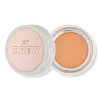Flower Beauty by Drew Chill Out Smoothing Color Corrector Versus e.l.f. cosmetics Putty Color-Correcting Eye Brightener
What's inside
What's inside
 Key Ingredients
Key Ingredients

 Benefits
Benefits

 Concerns
Concerns

 Ingredients Side-by-side
Ingredients Side-by-side

Caprylic/Capric Triglyceride
MaskingOctyldodecanol
EmollientHdi/Trimethylol Hexyllactone Crosspolymer
Cellulose
AbsorbentMica
Cosmetic ColorantEuphorbia Cerifera Wax
Silica
AbrasiveCopernicia Cerifera Wax
Trimethylsiloxysilicate
EmollientAdipic Acid/Diglycol Crosspolymer
Bisabolol
MaskingDimethicone
EmollientButylene Glycol Cocoate
EmulsifyingNylon-12
C12-15 Alkyl Benzoate
AntimicrobialGlyceryl Behenate
EmollientC18-36 Acid Triglyceride
EmollientTribehenin
EmollientCI 77120
Cosmetic ColorantPhenoxyethanol
PreservativePolyglyceryl-3 Diisostearate
EmulsifyingTriethoxycaprylylsilane
Hydrogenated Polydecene
EmollientEthylhexylglycerin
Skin ConditioningTocopherol
AntioxidantPolyhydroxystearic Acid
EmulsifyingJojoba Esters
EmollientWater
Skin ConditioningCannabidiol - Synthetically Produced
AntioxidantQuillaja Saponaria Root Extract
MaskingCaprylic/Capric Triglyceride, Octyldodecanol, Hdi/Trimethylol Hexyllactone Crosspolymer, Cellulose, Mica, Euphorbia Cerifera Wax, Silica, Copernicia Cerifera Wax, Trimethylsiloxysilicate, Adipic Acid/Diglycol Crosspolymer, Bisabolol, Dimethicone, Butylene Glycol Cocoate, Nylon-12, C12-15 Alkyl Benzoate, Glyceryl Behenate, C18-36 Acid Triglyceride, Tribehenin, CI 77120, Phenoxyethanol, Polyglyceryl-3 Diisostearate, Triethoxycaprylylsilane, Hydrogenated Polydecene, Ethylhexylglycerin, Tocopherol, Polyhydroxystearic Acid, Jojoba Esters, Water, Cannabidiol - Synthetically Produced, Quillaja Saponaria Root Extract
Octyldodecanol
EmollientDipentaerythrityl Hexahydroxystearate/Hexastearate/Hexarosinate
Skin ConditioningSynthetic Beeswax
Emulsion StabilisingSynthetic Wax
AbrasiveSqualane
EmollientVp/Hexadecene Copolymer
CI 77163
Cosmetic ColorantMicrocrystalline Wax
Emulsion StabilisingVp/Eicosene Copolymer
Synthetic Fluorphlogopite
Theobroma Cacao Seed Butter
EmollientPersea Gratissima Oil
Skin ConditioningJojoba Esters
EmollientEthylhexylglycerin
Skin ConditioningPolyhydroxystearic Acid
EmulsifyingLecithin
EmollientEthylhexyl Palmitate
EmollientIsopropyl Myristate
EmollientIsostearic Acid
CleansingPolyglyceryl-3 Polyricinoleate
EmulsifyingTin Oxide
AbrasiveSynthetic Sapphire
Tocopherol
AntioxidantRicinus Communis Seed Oil
MaskingWater
Skin ConditioningGlycerin
HumectantSodium Hyaluronate
HumectantHydrogenated Castor Oil
EmollientPanax Ginseng Root Extract
EmollientPhenoxyethanol
PreservativeCI 77891
Cosmetic ColorantIron Oxides
Octyldodecanol, Dipentaerythrityl Hexahydroxystearate/Hexastearate/Hexarosinate, Synthetic Beeswax, Synthetic Wax, Squalane, Vp/Hexadecene Copolymer, CI 77163, Microcrystalline Wax, Vp/Eicosene Copolymer, Synthetic Fluorphlogopite, Theobroma Cacao Seed Butter, Persea Gratissima Oil, Jojoba Esters, Ethylhexylglycerin, Polyhydroxystearic Acid, Lecithin, Ethylhexyl Palmitate, Isopropyl Myristate, Isostearic Acid, Polyglyceryl-3 Polyricinoleate, Tin Oxide, Synthetic Sapphire, Tocopherol, Ricinus Communis Seed Oil, Water, Glycerin, Sodium Hyaluronate, Hydrogenated Castor Oil, Panax Ginseng Root Extract, Phenoxyethanol, CI 77891, Iron Oxides
 Reviews
Reviews

Alternatives
Ingredients Explained
These ingredients are found in both products.
Ingredients higher up in an ingredient list are typically present in a larger amount.
Ethylhexylglycerin (we can't pronounce this either) is commonly used as a preservative and skin softener. It is derived from glyceryl.
You might see Ethylhexylglycerin often paired with other preservatives such as phenoxyethanol. Ethylhexylglycerin has been found to increase the effectiveness of these other preservatives.
Jojoba Esters is a wax created from Jojoba oil. It is an emollient and film-forming ingredient. In bead form, it is an exfoliator.
This ingredient has high oxidative stability, meaning it doesn't break down when exposed to oxygen.
Its similarity to our skin's natural oils makes it a great emollient. Emollients help soften and soothe our skin by creating a barrier on top. This barrier helps trap moisture in, keeping skin hydrated.
It is created using either the hydrogenation or transesterification processes on jojoba oil.
Learn more about Jojoba EstersOctyldodecanol is a fatty alcohol. It is primarily used to enhance the texture of products.
As an emulsifier, Octyldodecanol helps prevent the oils and waters from separating. It also prevents ingredients from creating foam when shaken.
Octyldodecanol is created by reducing fatty acid to an alcohol.
Due to its high molecular weight, it does not get absorbed into the skin.
Learn more about OctyldodecanolPhenoxyethanol is a preservative that has germicide, antimicrobial, and aromatic properties. Studies show that phenoxyethanol can prevent microbial growth. By itself, it has a scent that is similar to that of a rose.
It's often used in formulations along with Caprylyl Glycol to preserve the shelf life of products.
Polyhydroxystearic Acid is a soft wax made from castor oil.
It is is a texture thickener, emulsifier, and film-former. Emulsifiers prevent ingredients from separating, such as oils and waters.
Polyhydroxystearic Acid may not be fungal acne safe.
Learn more about Polyhydroxystearic AcidTocopherol (also known as Vitamin E) is a common antioxidant used to help protect the skin from free-radicals and strengthen the skin barrier. It's also fat soluble - this means our skin is great at absorbing it.
Vitamin E also helps keep your natural skin lipids healthy. Your lipid skin barrier naturally consists of lipids, ceramides, and fatty acids. Vitamin E offers extra protection for your skin’s lipid barrier, keeping your skin healthy and nourished.
Another benefit is a bit of UV protection. Vitamin E helps reduce the damage caused by UVB rays. (It should not replace your sunscreen). Combining it with Vitamin C can decrease sunburned cells and hyperpigmentation after UV exposure.
You might have noticed Vitamin E + C often paired together. This is because it is great at stabilizing Vitamin C. Using the two together helps increase the effectiveness of both ingredients.
There are often claims that Vitamin E can reduce/prevent scarring, but these claims haven't been confirmed by scientific research.
Learn more about TocopherolWater. It's the most common cosmetic ingredient of all. You'll usually see it at the top of ingredient lists, meaning that it makes up the largest part of the product.
So why is it so popular? Water most often acts as a solvent - this means that it helps dissolve other ingredients into the formulation.
You'll also recognize water as that liquid we all need to stay alive. If you see this, drink a glass of water. Stay hydrated!
Learn more about Water